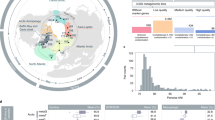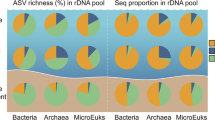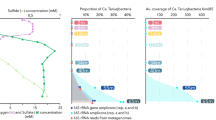Abstract
The Arctic Ocean plays a critical role in controlling nutrient budgets between the Pacific and Atlantic Ocean. Archaea are key players in the nitrogen cycle and in cycling nutrients, but their community composition has been little studied in the Arctic Ocean. Here, we characterize archaeal assemblages from surface and deep Arctic water masses using massively parallel tag sequencing of the V6 region of the 16S rRNA gene. This approach gave a very high coverage of the natural communities, allowing a precise description of archaeal assemblages. This first taxonomic description of archaeal communities by tag sequencing reported so far shows that it is possible to assign an identity below phylum level to most (95%) of the archaeal V6 tags, and shows that tag sequencing is a powerful tool for resolving the diversity and distribution of specific microbes in the environment. Marine group I Crenarchaeota was overall the most abundant group in the Arctic Ocean and comprised between 27% and 63% of all tags. Group III Euryarchaeota were more abundant in deep-water masses and represented the largest archaeal group in the deep Atlantic layer of the central Arctic Ocean. Coastal surface waters, in turn, harbored more group II Euryarchaeota. Moreover, group II sequences that dominated surface waters were different from the group II sequences detected in deep waters, suggesting functional differences in closely related groups. Our results unveiled for the first time an archaeal community dominated by group III Euryarchaeota and show biogeographical traits for marine Arctic Archaea.
Similar content being viewed by others
Log in or create a free account to read this content
Gain free access to this article, as well as selected content from this journal and more on nature.com
or
References
Agogue H, Brink M, Dinasquet J, Herndl GJ . (2008). Major gradients in putatively nitrifying and non-nitrifying Archaea in the deep North Atlantic. Nature 456: 788–791.
Aller JY, Kemp PF . (2008). Are Archaea inherently less diverse than bacteria in the same environments? FEMS Microbiol Ecol 65: 74–87.
Arrigo KR . (2005). Marine microorganisms and global nutrient cycles. Nature 437: 349–355.
Auguet JC, Casamayor EO . (2008). A hotspot for cold crenarchaeota in the neuston of high mountain lakes. Environ Microbiol 10: 1080–1086.
Bano N, Ruffin S, Ransom B, Hollibaugh JT . (2004). Phylogenetic composition of Arctic Ocean archaeal assemblages and comparison with Antarctic assemblages. Appl Environ Microbiol 70: 781–789.
Casamayor EO, Massana R, Benlloch S, Ovreas L, Diez B, Goddard VJ et al. (2002). Changes in archaeal, bacterial and eukaryal assemblages along a salinity gradient by comparison of genetic fingerprinting methods in a multipond solar saltern. Environ Microbiol 4: 338–348.
Clementino MM, Fernandes CC, Vieira RP, Cardoso AM, Polycarpo CR, Martins OB . (2007). Archaeal diversity in naturally occurring and impacted environments from a tropical region. J Appl Microbiol 103: 141–151.
Cole JR, Wang Q, Cardenas E, Fish J, Chai B, Farris RJ et al. (2009). The Ribosomal Database Project: improved alignments and new tools for rRNA analysis. Nucleic Acids Res 37: D141–D145.
DeLong EF, Preston CM, Mincer T, Rich V, Hallam SJ, Frigaard NU et al. (2006). Community genomics among stratified microbial assemblages in the ocean′s interior. Science 311: 496–503.
Edgar RC . (2004). MUSCLE: multiple sequence alignment with high accuracy and high throughput. Nucleic Acids Res 32: 1792–1797.
Felsenstein J . (2004). PHYLIP (Phylogeny Inference Package). version 3 Distributed by the author. Department of Genome Sciences, University of Washington, Seattle.
Francis CA, Beman JM, Kuypers MMM . (2007). New processes and players in the nitrogen cycle: the microbial ecology of anaerobic and archaeal ammonia oxidation. ISME J 1: 19–27.
Frigaard NU, Martinez A, Mincer TJ, DeLong EF . (2006). Proteorhodopsin lateral gene transfer between marine planktonic Bacteria and Archaea. Nature 439: 847–850.
Fuhrman JA, Davis AA . (1997). Widespread Archaea and novel bacteria from the deep sea as shown by 16S rRNA gene sequences. Mar Ecol Prog Ser 150: 275–285.
Galand PE, Lovejoy C, Vincent WF . (2006). Remarkably diverse and contrasting archaeal communities in a large arctic river and the coastal Arctic Ocean. Aqua Microbial Ecol 44: 115–126.
Galand PE, Lovejoy C, Pouliot J, Garneau ME, Vincent WF . (2008a). Microbial community diversity and heterotrophic production in a coastal arctic ecosystem: A Stamukhi lake and its source waters. Limnol Oceanogr 53: 813–823.
Galand PE, Lovejoy C, Pouliot J, Vincent WF . (2008b). Heterogeneous archaeal communities in the particle-rich environment of an arctic shelf ecosystem. J Marine Syst 74: 774–782.
Galand PE, Lovejoy C, Hamilton AK, Ingram RG, Pedneault E, Carmack E . (2009). Archaeal diversity and a gene for ammonia oxidation are coupled to oceanic circulation. Environ Microbiol doi:10.1111/j.1462-2920.2008.01822.x.
Garneau ME, Roy S, Lovejoy C, Gratton Y, Vincent WF . (2008). Seasonal dynamics of bacterial biomass and production in a coastal arctic ecosystem: Franklin Bay, western Canadian Arctic. J Geophys. Res 113: C07S91, doi:10.1029/2007JC004281.
Hallam SJ, Konstantinidis KT, Putnam N, Schleper C, Watanabe YI, Sugahara J . (2006a). Genomic analysis of the uncultivated marine crenarchaeote Cenarchaeum symbiosum. Proc Natl Acad Sci USA 103: 18296–18301.
Hallam SJ, Mincer TJ, Schleper C, Preston CM, Roberts K, Richardson PM et al. (2006b). Pathways of carbon assimilation and ammonia oxidation suggested by environmental genomic analyses of marine Crenarchaeota. PLoS Biol 4: e95.
Herndl GJ, Reinthaler T, Teira E, van Aken H, Veth C, Pernthaler A et al. (2005). Contribution of Archaea to total prokaryotic production in the deep Atlantic Ocean. Appl Environ Microbiol 71: 2303–2309.
Huber JA, Mark Welch DB, Morrison HG, Huse SM, Neal PR, Butterfield DA et al. (2007). Microbial population structures in the deep marine biosphere. Science 318: 97–100.
Huse S, Huber J, Morrison H, Sogin M, Welch D . (2007). Accuracy and quality of massively parallel DNA pyrosequencing. Genome Biol 8: R143.
Jones EP, Swift JH, Anderson LG, Lipizer M, Civitarese G, Falkner KK et al. (2003). Tracing Pacific water in the North Atlantic Ocean. J Geophys Res-Oceans 108: 1–10.
Karner MB, DeLong EF, Karl DM . (2001). Archaeal dominance in the mesopelagic zone of the Pacific Ocean. Nature 409: 507–510.
Kirchman DL, Elifantz H, Dittel AI, Malmstrom RR, Cottrell MT . (2007). Standing stocks and activity of Archaea and Bacteria in the western Arctic Ocean. Limnol Oceanogr 52: 495–507.
Konneke M, Bernhard AE, de la Torre JR, Walker CB, Waterbury JB, Stahl DA . (2005). Isolation of an autotrophic ammonia-oxidizing marine archaeon. Nature 437: 543–546.
Lam P, Jensen MM, Lavik G, McGinnis DF, Muller B, Schubert CJ . (2007). Linking crenarchaeal and bacterial nitrification to anammox in the Black Sea. Proc Natl Acad Sci USA 104: 7104–7109.
López-García P, Moreira D, López-López A, Rodríguez-Valera F . (2001). A novel haloarchaeal-related lineage is widely distributed in deep oceanic regions. Environ Microbiol 3: 72–78.
Malmstrom RR, Straza TRA, Cottrell MT, Kirchman DL . (2007). Diversity, abundance, and biomass production of bacterial groups in the western Arctic Ocean. Aqua Microbial Ecol 47: 45–55.
Martin-Cuadrado AB, Lopez-Garcia P, Alba JC, Moreira D, Monticelli L, Strittmatter A . (2007). Metagenomics of the deep Mediterranean, a warm bathypelagic habitat. PLoS ONE 2: e914.
Martin-Cuadrado AB, Rodriguez-Valera F, Moreira D, Alba JC, Ivars-Martinez E, Henn MR et al. (2008). Hindsight in the relative abundance, metabolic potential and genome dynamics of uncultivated marine archaea from comparative metagenomic analyses of bathypelagic plankton of different oceanic regions. ISME J 2: 865–886.
Massana R, DeLong EF, Pedros-Alio C, Murray AE, Preston CM . (2000). A few cosmopolitan phylotypes dominate planktonic archaeal assemblages in widely different oceanic provinces. Appl Environ Microbiol 66: 1777–1787.
McLaughlin FA, Carmack EC, Macdonald RW, Melling H, Swift JH, Wheeler PA et al. (2004). The joint roles of Pacific and Atlantic-origin waters in the Canada Basin, 1997–1998. Deep Sea Res Pt I 51: 107–128.
Mehta MP, Huber JA, Baross JA . (2005). Incidence of novel and potentially archaeal nitrogenase genes in the deep Northeast Pacific Ocean. Environ Microbiol 7: 1525–1534.
Mincer TJ, Church MJ, Taylor LT, Preston C, Karl DM, DeLong EF . (2007). Quantitative distribution of presumptive archaeal and bacterial nitrifiers in Monterey Bay and the North Pacific Subtropical Gyre. Environ Microbiol 9: 1162–1175.
Nusch E . (1980). Comparison of different methods for chlorophyll and phaeopigment determination. Arch Hydrobiol Beih 14: 14–36.
Pouliot J, Galand PE, Lovejoy C, Vincent WF . (2009). Vertical structure of archaeal communities and the distribution of ammonia monooxygenase A gene variants in two meromictic High Arctic lakes. Environ Microbiol 11: 687–699.
Pruesse E, Quast C, Knittel K, Fuchs BM, Ludwig W, Peplies J et al. (2007). SILVA: a comprehensive online resource for quality checked and aligned ribosomal RNA sequence data compatible with ARB. Nucleic Acids Res 35: 7188–7196.
Rudels B, Jones PE, Schauer U, Eriksson P . (2004). Atlantic sources of the Arctic Ocean surface and halocline waters. Polar Res 23: 181–208.
Schloss PD, Handelsman J . (2005). Introducing DOTUR, a computer program for defining operational taxonomic units and estimating species richness. Appl Environ Microbiol 71: 1501–1506.
Sogin ML, Morrison HG, Huber JA, Welch DM, Huse SM, Neal PR et al. (2006). Microbial diversity in the deep sea and the under explored “rare biosphere”. Proc Natl Acad Sci USA 103: 12115–12120.
Tang CCL, Ross CK, Yao T, Petrie B, DeTracey BM, Dunlap E . (2004). The circulation, water masses and sea-ice of Baffin Bay. Prog Oceanogr 63: 183–228.
Teira E, van Aken H, Veth C, Herndl GJ . (2006). Archaeal uptake of enantiomeric amino acids in the meso- and bathypelagic waters of the North Atlantic. Limnol Oceanogr 51: 60–69.
Thompson JD, Higgins DG, Gibson TJ . (1994). CLUSTAL W: improving the sensitivity of progressive multiple sequence alignment through sequence weighting, position-specific gap penalties and weight matrix choice. Nucleic Acids Res 22: 4673–4680.
Wang Q, Garrity GM, Tiedje JM, Cole JR . (2007). Naive bayesian classifier for rapid assignment of rRNA sequences into the new bacterial taxonomy. Appl Environ Microbiol 73: 5261–5267.
Wuchter C, Abbas B, Coolen MJL, Herfort L, van Bleijswijk J, Timmers P et al. (2006). Archaeal nitrification in the ocean. Proc Natl Acad Sci USA 103: 12317–12322.
Yamamoto-Kawai M, Carmack E, McLaughlin F . (2006). Nitrogen balance and Arctic throughflow. Nature 443: 43.
Acknowledgements
P E Galand is supported by a Marie Curie grant (CRENARC MEIF-CT-2007–040247). EO Casamayor was supported by a Spanish grant CGL2006–12058-BOS, and D L Kirchman by NSF OPP ARC-0632233. C Lovejoy would like to acknowledge the support of the Natural Sciences and Engineering Council, Canada (NSERC) Special Research Opportunity Fund. We thank C Pedros-Alio for support during CASES. Deep Arctic samples were collected by K Scarcella and E Didierjean, and we thank the Chief Scientist, Officers and Crew of the CCGS Louis St Laurent and support from Fisheries and Oceans Canada. Tag sequencing was supported by a Keck foundation grant to M Sogin and L Ameral Zettler. This is a contribution to the International Census of Marine Microbes (ICOMM).
Author information
Authors and Affiliations
Corresponding author
Additional information
Supplementary Information accompanies the paper on The ISME Journal website (http://www.nature.com/ismej)
Supplementary information
Rights and permissions
About this article
Cite this article
Galand, P., Casamayor, E., Kirchman, D. et al. Unique archaeal assemblages in the Arctic Ocean unveiled by massively parallel tag sequencing. ISME J 3, 860–869 (2009). https://doi.org/10.1038/ismej.2009.23
Received:
Revised:
Accepted:
Published:
Issue date:
DOI: https://doi.org/10.1038/ismej.2009.23
Keywords
This article is cited by
-
Vertical distribution and phylogenetic characterization of marine Archaea in the western subarctic Pacific
Marine Development (2024)
-
Vertical segregation and phylogenetic characterization of archaea and archaeal ammonia monooxygenase gene in the water column of the western Arctic Ocean
Extremophiles (2023)
-
High diversity of planktonic prokaryotes in Arctic Kongsfjorden seawaters in summer 2015
Polar Biology (2021)
-
Marine Group-II archaea dominate particle-attached as well as free-living archaeal assemblages in the surface waters of Kongsfjorden, Svalbard, Arctic Ocean
Antonie van Leeuwenhoek (2021)
-
Compendium of 530 metagenome-assembled bacterial and archaeal genomes from the polar Arctic Ocean
Nature Microbiology (2021)



